Our CNC router takes a two or three dimensional computer model of an object and very precisely mills, cuts, or shapes the object out of any soft material. This low-priced high-quality desktop CNC router cuts intricate and accurate pieces. The machine allows an individual to shape objects that would otherwise be too tedious, difficult, or impossible to complete by hand. Our router can cut wood, plastic, foam, and many other soft materials. It is not intended to cut metals, however we learned recently that it can easily carve basic red bricks. We regularly experiment with new materials to increase the potential applications of our machine. For an updated list of materials we have tested, visit the “Tools and Materials” page on our website as well as the “Updates” section on our Kickstarter page. The frame and mechanical components of our CNC router are custom designed from the ground up to minimize the cost of the machine without incurring any unacceptable loss of performance. We are trying to provide something that people have been able to purchase for a couple of years, but at a fraction of the price.
The Router’s Specs:
- Custom closed loop controller
- 9.2in x 8.7in x 1.9in workspace (234mm x 221mm x 48mm) (cutting/working area)
- 12in x 14in x 14in machine size (dimensions of the entire machine)
- .00005in (.001mm) minimum step size (the minimum amount the machine can be instructed to move)
- .1mm – .5mm repeatability depending on feed rate and material (the ability to return to the same spot after a process; accuracy)
- 5in/min (127mm/min) maximum feed rate (the rate it can move in any one direction). For those unfamiliar with feed rates, compared to more expensive CNC setups, this is very slow.

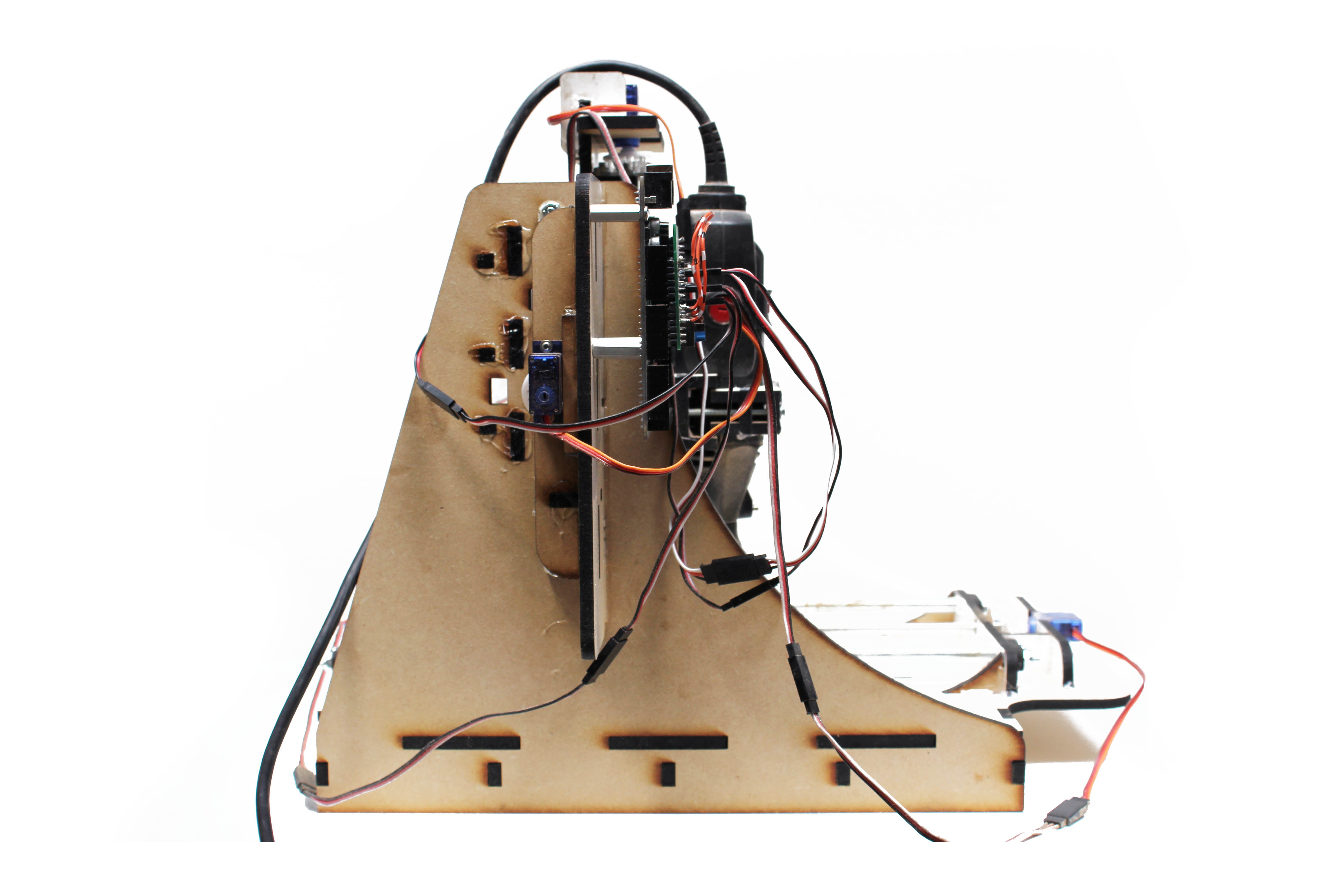

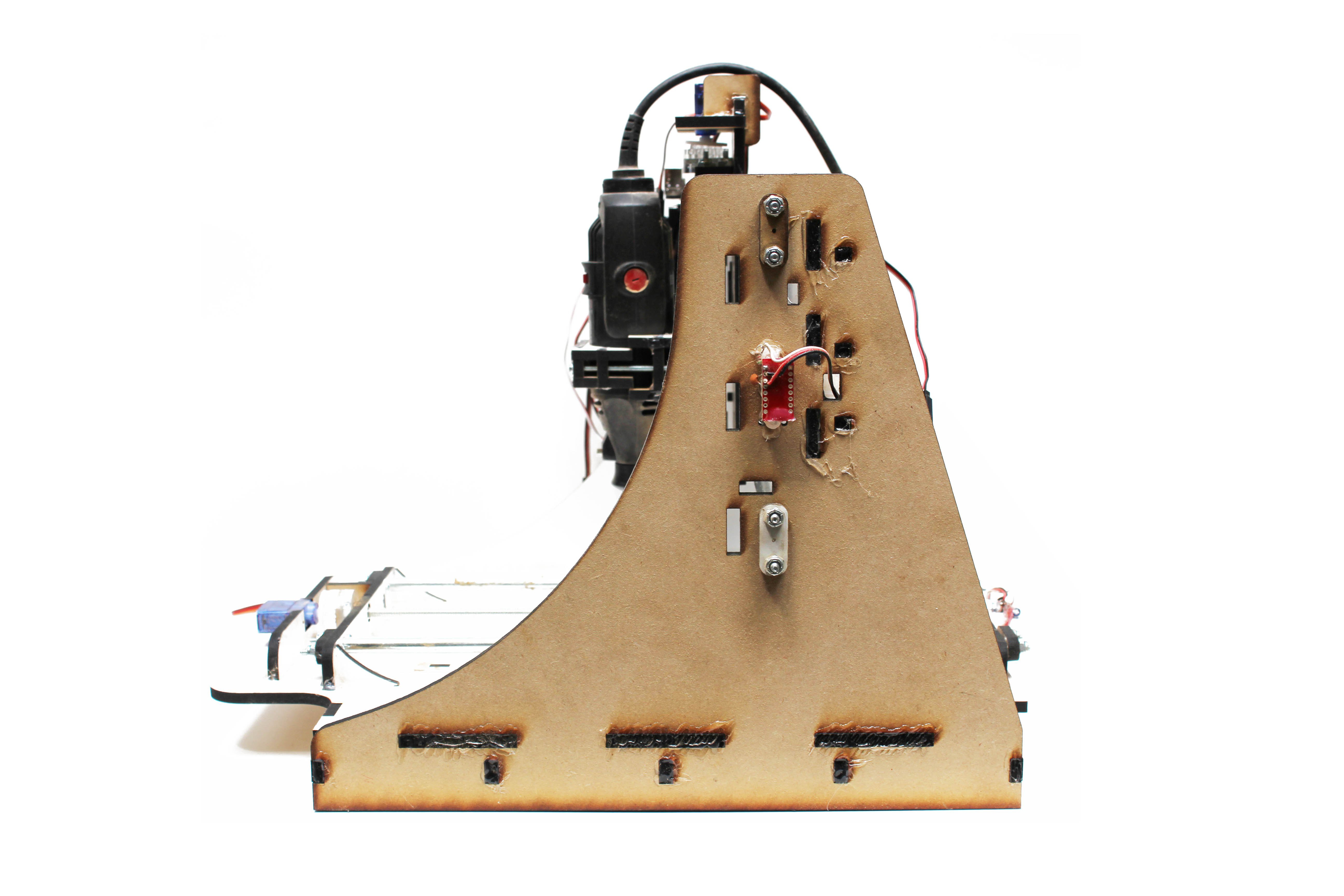
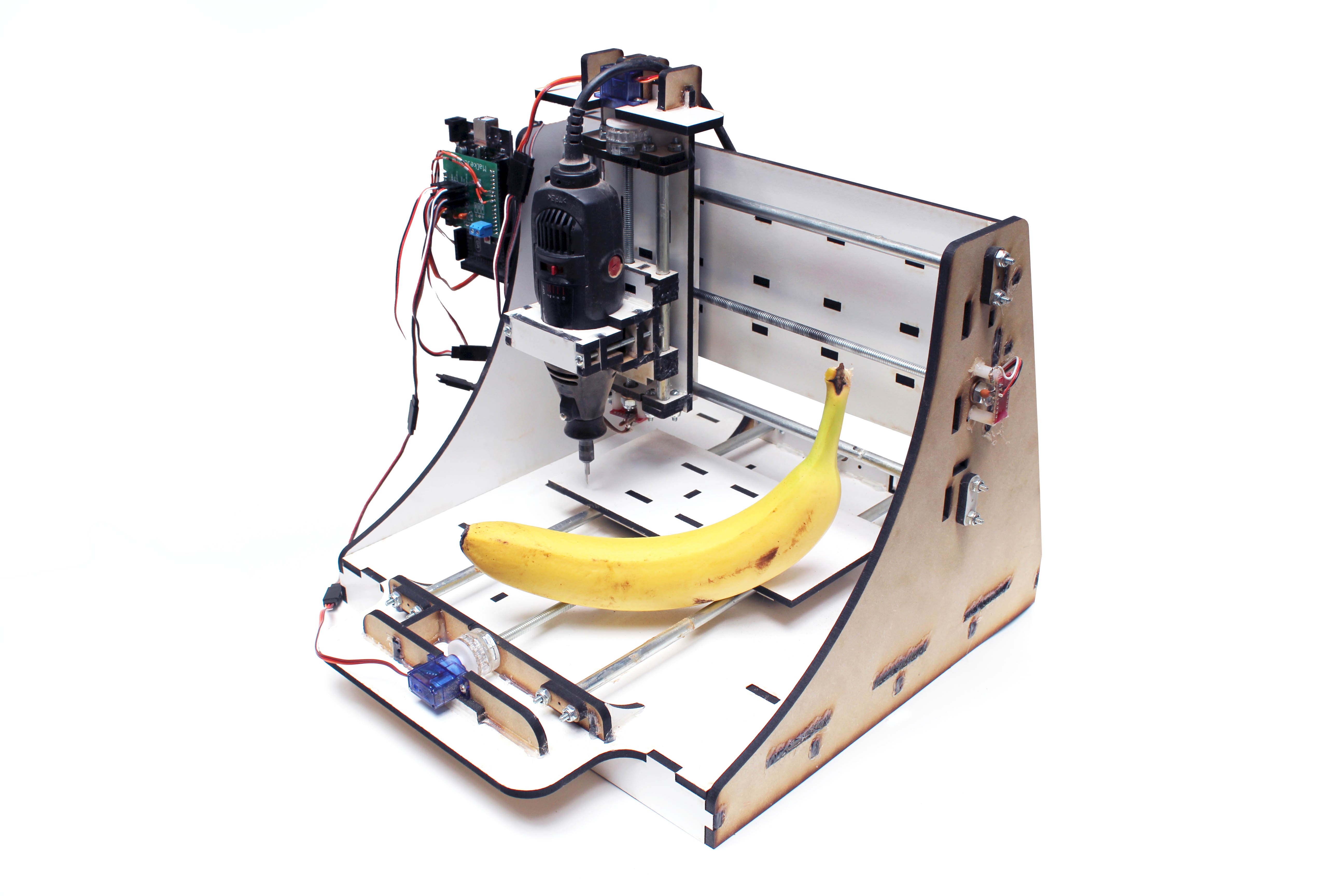
Tools: End Mills, Drill Bits, V-bits
Materials: Wood, Plywood, Brick, Foam, Copper Clad PCB Board, Leather, Steel, 3D Printed ABS, Delrin
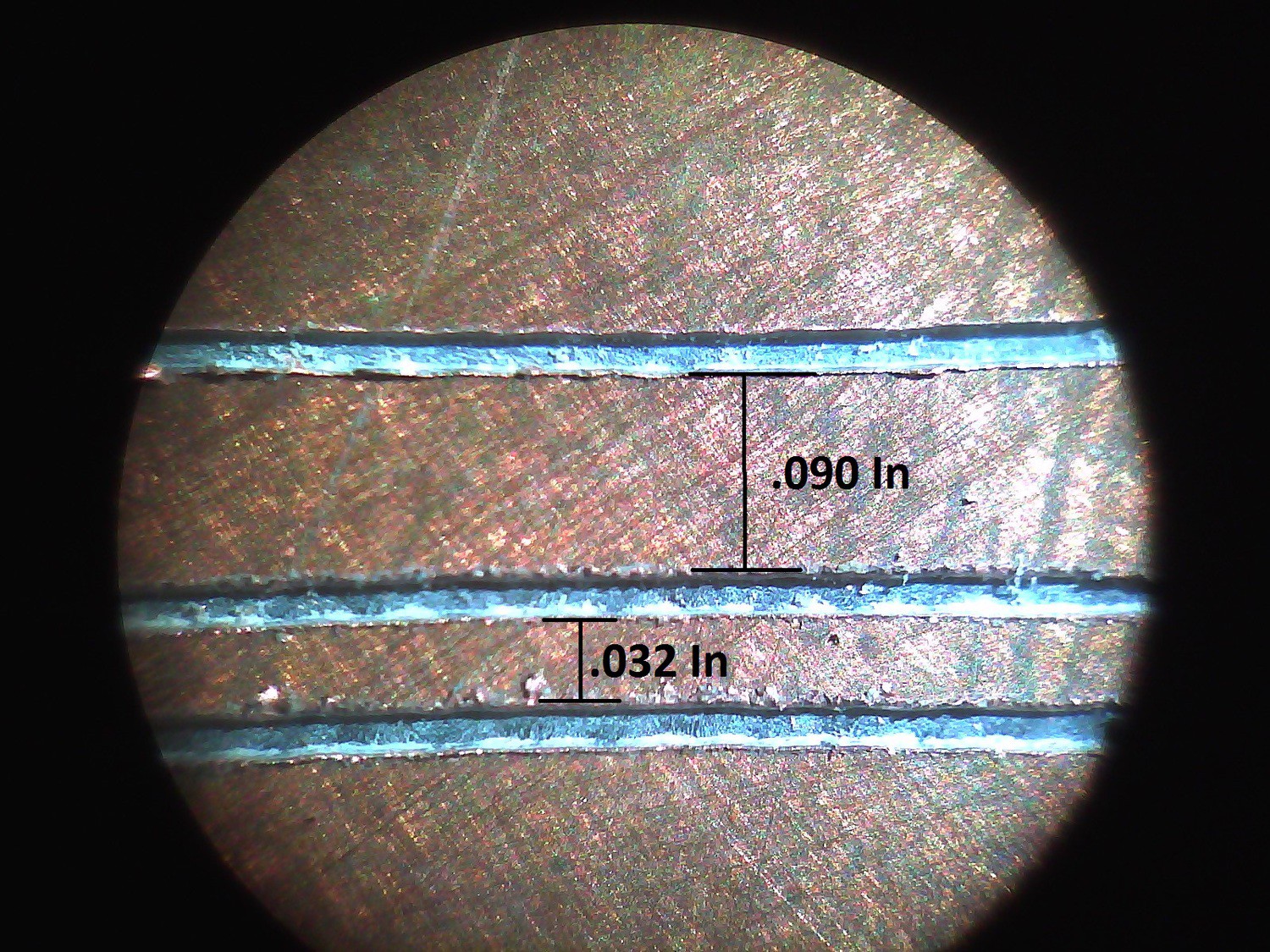
End Mill:
An end mill is a bit which is designed to cut in as it moves through material in any direction. End mills are useful for cutting out a shape by cutting all the way through, or to create pockets or slots by cutting only partially through the material. The general rule is that an end mill should only cut to a depth of about 1/2 to 1/4th of it’s diameter with each pass, so a 2mm end mill might step down 1mm with each pass. If you are using a .8mm end mill it’s probably not practical to follow this rule, but it’s worth keeping in mind.
The picture below is of a 2mm end mill. The second picture is of the same 2mm end mill with a .8mm end mill next to it for comparison. Both pictures were taken through a microscope.
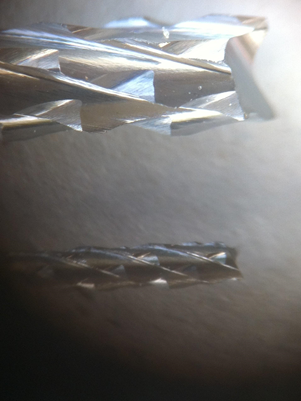
Shown are a 2mm and a .8mm toothed end mill.
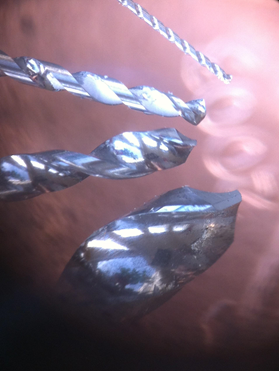
V-bits:
V-bits are mostly useful for engraving text or routing circuit boards. V-bits are nice because they leave an attractive v-shaped groove and they are typically much cheaper than an end mill of comparable size and material. Buy the tungsten carbide ones, they are worth it. You can find these on ebay pretty easily.
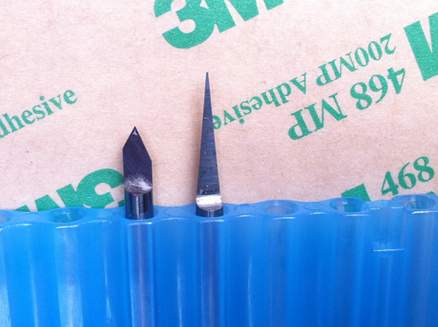
The picture below is a view of the upper right corner of the ‘M’ from the engraving seen through a microscope. The engraving was made with a 45 degree v-bit.
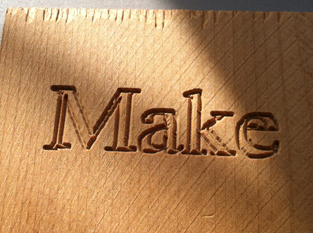
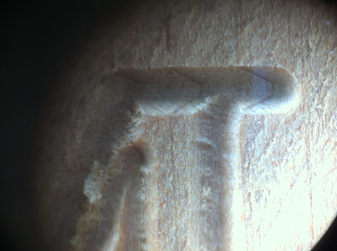
Materials:
Wood is one of the best materials out there. It is strong, light, easy to work with, beautiful, readily available, and inexpensive. Wood is a broad category ranging from balsa wood to iron wood, so you will have to do some experimenting to see what works best for any particular wood. In general, wood will yield accurate and beautiful objects and can either be cut or engraved. When cutting wood it is important not to burn the wood or your end mill. Rotary tools often can be set to very high speeds (30,000 RPM or higher). These kinds of speeds will cause your end mill to heat up rapidly and burn the wood you are cutting. To prevent this from happening, when cutting wood, use a lower spindle speed in conjunction with a relatively high feed rate (feed rate is how fast the bit is moving laterally) and a small step down (a step down is how much deeper the bit cuts with each pass). This combination lets you maintain accuracy without burning your bit.

One of a number of pieces that combine to form the rib for a wooden kayak
Plywood
Plywood is useful because it has similar properties to wood but it is available in large flat sheets which makes it easy to design with and cut. Similar to wood, you want to keep your feed rates up and your step down small when cutting plywood. I keep a stack of plywood “blanks” next to my machine so that if I think of something I want to cut out they are ready to go. It’s useful when cutting plywood to put a sacrificial piece of foam underneath so that when you cut through the plywood you don’t cut into the bed of the machine.
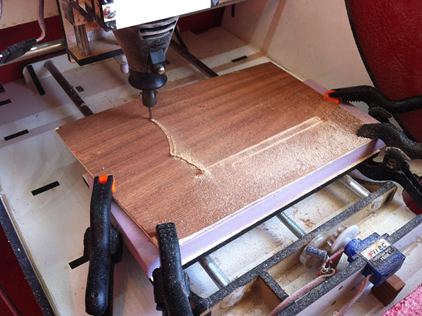
The router cuts out a costume party prop. Note the sacrificial foam under the wood.
The router makes a piece for a iphone-to-microscope camera mount.
Foam
Foam is an interesting material with some useful properties. It combines light weight with reasonably high strength and soft surface texture. I recommend fan-fold insulation foam which is available in big sheets at any home improvement store. Fan-fold foam has small pores which makes it ideal a range of applications from mold making to lost foam casting to RC airplane parts. The downside to foam is that it makes awful dust when you cut it. You can cut foam at any feed rate and spindle speed because it is so soft.There are a lot of types of foam out there, almost all of them produce dust which is toxic and some produce harmful gasses when cut as well. Always work in a well ventilated area and take the proper precautions to insulate yourself from harmful dust and gasses when working with foam.


Brick
For brick use a high spindle speed in conjunction with a low feed rate and a small step down (I used .2mm). This means that it takes a long time to cut, but it cuts cleanly
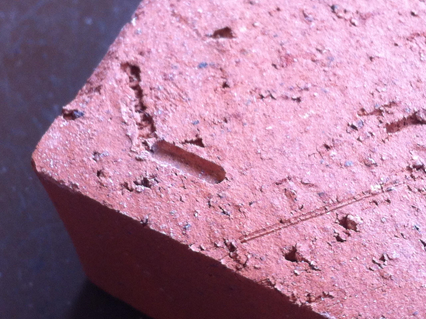
Copper Clad PCB Board
Copper Clad PCB Board is made from a sheet of FR4 (fiberglass) sandwiched between two sheets of thin copper. Copper clad board can be found online or likely at your local electronics supply store. It is used to make circuit boards through a chemical etching processes or by cutting away the copper to isolate traces. Making PCBs at home has long been one of the holy grails of digital fabrication.
I hope to have a complete circuit board cut soon, but I have been unable to do a full board because I am having trouble getting heeksCAD (The CAM software I use) to read my digital circuit files. Preliminary tests look good however. Because of the exceedingly high accuracy required to make a PCB you must put love and care into doing it right. To cut copper clad board you can use a v-bit which costs only about dollar or use an expensive tiny end mill which can cost as much as $25. Using a small end mill results in a noticeably cleaner cut, but they are obviously much more expensive. To cut copper clad board,you want to use the maximum spindle speed of which your dremel is capable, and a low feed rate. There isn’t a low-end on how slow you should go, the slower you go the better the board will look. Backlash becomes a big issue when cutting PCBs because slight inaccuracies in the router’s movements can result in small pieces of copper remaining connected.
When cutting a circuit board,depth is crucial. I recommend moving the bit close to the surface of the material and then stepping it down in .1mm steps until it just hardly cuts through.
You will need to find and cut any uncut connections before a PCB can be used. So how small of traces can you make? I’m not sure at this point. I would say that DIP (through-hole) part are viable with no problem and SMD parts as small as 1206 and MAYBE 0805 parts are reasonable to try to hope for, but packages like the SSOT16 will be impossible on this type of mill.

A 1206 resistor soldered onto a routed PCB.

A 12 mil (twelve thousandths of an inch wide) trace next to an 0805 resistor. Can you produce this type of accuracy constantly over a 9 inch by 9 inch circuit board? Almost certainly not.
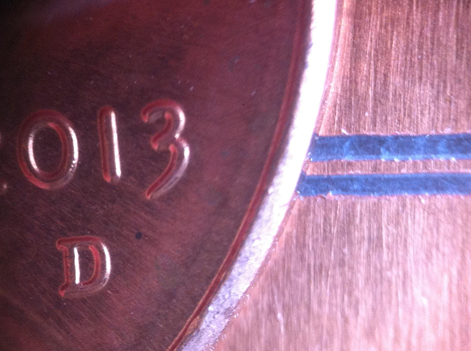
The same 12 mil trace with a penny added for scale.
Delrin
Delrin is a hard plastic which is known for machining well. As expected, it does.
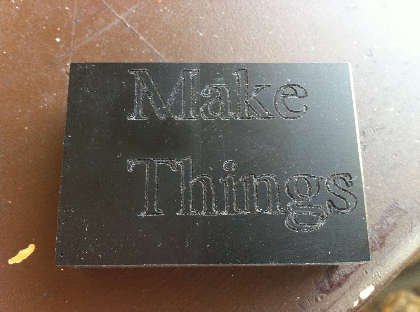
3D Printed ABS
I was asked about the possibility of cutting a part which had already been 3D printed in ABS so I tracked down a print that had gone awry from a friends printer and tried it. I was a little worried that the router bit would bind up because 3D printed ABS is formulated specifically to melt, but it cuts great. I would recommend using an end mill with decent sized flutes to remove the chip.
Leather
Leather can be either cut with an end mill or engraved with a v-bit. The spindle speed varies with the type of leather and the bit being used.

There are a number of other materials I would like to experiment with. I will update this page as I try them.
 brashtim
brashtim